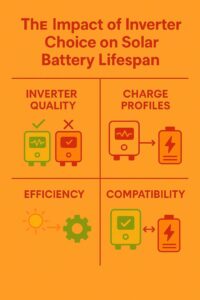Choosing the right inverter for your solar energy system is not just a matter of efficiency—it directly influences the long-term performance and lifespan of your solar battery. As solar technology becomes more accessible and energy storage more common, understanding the role of inverter quality, charge profiles, and system compatibility is critical to protecting your investment. This article examines how inverter selection affects battery degradation and what homeowners and businesses in Perth should know when integrating solar and storage.
Inverter Quality: Why It Matters
An inverter serves as the critical link between your solar panels, battery storage, and home or business power usage. High-quality inverters maintain consistent voltage and current, preventing stress on battery cells during charging and discharging. Poor-quality or incompatible inverters can lead to irregular charge rates, over-voltage, or under-voltage conditions, accelerating the deterioration of battery chemistry.
Advanced solar inverters are designed to integrate intelligently with solar batteries, adjusting outputs based on real-time power demands and storage conditions. In contrast, outdated or basic models may lack the ability to properly manage battery parameters, resulting in inefficient charging cycles and reduced usable battery life.
Charge Profiles & Battery Health
A charge profile defines how an inverter charges a solar battery—this includes parameters like voltage levels, current flow, float charging, and equalisation cycles. Each battery chemistry (such as lithium-ion, lead-acid, or flow batteries) has a specific charge profile that must be matched accurately by the inverter.
Incorrect charge profiles can lead to common degradation issues such as:
- Overcharging: Causes excessive heat and chemical breakdown in battery cells.
- Undercharging: Prevents full energy storage, leading to reduced capacity over time.
- Inconsistent Cycling: Fluctuations in current can strain internal battery components.
In Perth, where solar energy production is high during summer months, precise charge control is essential to prevent thermal and electrical stress on the battery. Modern solar inverters with programmable charge profiles offer greater control, ensuring optimal performance across all seasons.

Inverter Efficiency & Battery Usage Cycles
Efficiency ratings of inverters play a hidden yet critical role in solar battery lifespan. Every time energy is converted—solar DC to AC or stored energy discharged from the battery—there are inherent losses. A low-efficiency inverter may cause more frequent cycling of the battery to compensate for these losses, accelerating wear and reducing the total cycle life.
For example, a system with a 90% efficient inverter may require 10% more energy from the battery for the same output compared to a system using a 97% efficient inverter. This additional cycling adds up over time, especially in residential systems where daily cycling is common.
Pairing your battery with a high-efficiency solar inverter in Perth ensures that minimal energy is wasted and the battery only cycles as needed, extending its operational lifespan and reducing long-term maintenance costs.
Compatibility Between Inverters & Batteries
Not all inverters are designed to work with all solar batteries. Compatibility goes beyond connectors—software integration, communication protocols, and algorithmic syncing must align to maintain correct operation. Without seamless communication, the inverter may misread battery charge levels or apply incorrect settings, contributing to uneven wear or even early failure.
Smart hybrid inverters with built-in energy management systems can monitor and adapt based on real-time battery data. These systems help avoid deep discharges, maintain stable voltage, and minimise strain during peak loads—crucial factors for maximising solar battery life.
The Perth Context: Local Conditions & Installer Expertise
In Western Australia, solar installations must factor in high UV exposure, temperature extremes, and grid instability in some areas. A reliable solar battery in Perth must be supported by an inverter that can handle these local variables without compromising system health.
Furthermore, installation quality matters. Poor configuration, incorrect inverter selection, or lack of commissioning testing can result in premature battery degradation—even if the individual components are high quality.
Working with experienced solar professionals who understand Perth’s grid conditions, local compliance standards, and battery-inverter pairing best practices is essential to ensure system longevity.
Conclusion
Inverter choice is not an afterthought—it’s a key determinant in the health, efficiency, and return on investment of any solar battery system. Choosing an inverter with precise charge control, high efficiency, and proven battery compatibility ensures your system delivers reliable energy and avoids premature battery replacement.
For those considering or upgrading their solar system, investing in the right inverter will protect your solar battery, minimise degradation, and optimise performance for years to come.

